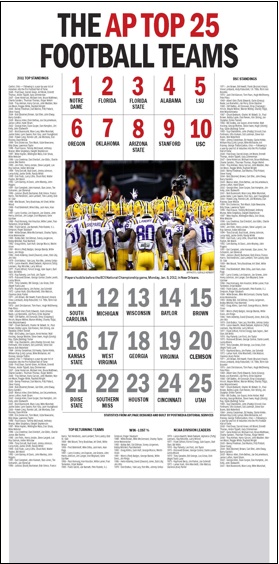

At a time when “digital first” is the slogan du jour in newspaper corner offices, the Associated Press is offering its subscribers a product — one that’s meant to be printed out, ink-on-paper style.
Starting this week, the wire service will distribute paginated sports specials to preview major events like the NFL draft, Major League Baseball playoffs, NASCAR’s Cup Series, and top golf tournaments. The series is branded AP Sports Extra, and the first one will preview the British Open this week. The 10 annual extras will be free to newspapers that already subscribe to AP Sports content, and they’re an attempt to help AP members who’ve cut back on their sports copy desks — with a revenue-generating twist.
Jim Reindl, who’s in charge of sports products and business development at the AP, says the print-focused initiative definitely “caught a few people by surprise” when he first pitched it internally.
“I would say the reaction initially was: ‘Hmm. Pagination, huh?'” Reindl told me. “But you know, it’s not a product that’s foreign to us. It’s not a business model that AP has entertained, like going into the pagination business, but we’ve certainly talked about it on and off over the years.”
Sports coverage has been an area of recent experimentation for the AP. Last year, it started offering multiple versions of baseball stories so that the hometown of the losing team had coverage better tailored to local readers’ narrative interests. (When your team loses, you want to know how they blew it before you read about how the other team won.) That “hometown ledes” project was so popular that the AP began offering multiple versions of college and pro football game stories, too.
Hometown ledes came out of the editorial department, and sought to help newspapers save money by making it so they didn’t have to send reporters to every away game. Sports Extra is also about leveraging resources, but it’s aimed at increasing ad revenue rather than cutting costs. As Reindl puts it, the AP sees an opportunity to “add value,” literally, where newspapers need it most.
 Sports Extras will come with a ready-to-sell ad hole, and newspapers will get the schedule of extras a year in advance to help sales teams sell ads. The inclusion of photos on some Sports Extra pages is a small bonus for the relatively small number of AP Sports subscribers that don’t also subscribe to the wire service’s photos. The special pages will be distributed through AP Exchange — the place where newspapers already go to select AP stories and photos for publication — so Reindl says it won’t require any training or effort to find the new pages. (They’ll be available in broadsheet, half-broadsheet, and tabloid sizes.)
Sports Extras will come with a ready-to-sell ad hole, and newspapers will get the schedule of extras a year in advance to help sales teams sell ads. The inclusion of photos on some Sports Extra pages is a small bonus for the relatively small number of AP Sports subscribers that don’t also subscribe to the wire service’s photos. The special pages will be distributed through AP Exchange — the place where newspapers already go to select AP stories and photos for publication — so Reindl says it won’t require any training or effort to find the new pages. (They’ll be available in broadsheet, half-broadsheet, and tabloid sizes.)
The overhead cost for the AP minimal. Postmedia Editorial Services, the Toronto company that’s producing the series, already does lots of layout outsourcing for U.S. and Canadian newspapers. “What they want to be able to do is have the AP sports content in-house, and make it easier for them to go to any paper and say, ‘Look, we can do sports,'” Reindl said.
In coming months, the AP will assess its events line-up. Reindl also says he doesn’t expect Sports Extras to work in every market, and he’s already heard “mixed reactions” from newspapers. Some worry about the cost burden associated with printing extra pages — even if those pages are able to bring in more ad dollars.
“Frankly, it’s an experiment,” Reindl said. “We’re going forward with it and we’ll have to see how the market really adapts to it. This is an opportunity where we can try to help the industry still make money off of its core print product. The proof is always in the pudding.”
Photo of Citizens Bank Park by Andrew Bartlett used under a Creative Commons license.